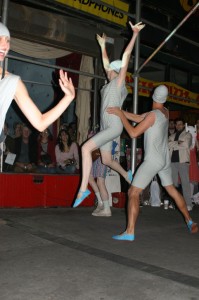Taking it to the Streets: One Million Forgotten Moments
May 27, 2011
Published: September 27, 2007
The Lower Manhattan Cultural Council (LMCC) and director Yehuda Duenyas have put together an amazingly brilliant project, transforming the once-adult video shop at 38 Park Row into an 18th century jewel box theatre. Running from Sept. 11-16, the project was titled “One Million Forgotten Moments,” in which over 120 of New York’s most talented artists came together to remember not only Sept. 11, but to remind the city what it is like to be a New Yorker.

The audience sat inside the miniscule shop looking out onto the busy street of Park Row while the actors performed around everyday life outside. We were offered fans for heat discomfort because the theatre could only hold a capacity of 25 people and opera glasses were distributed to view parts of the show that were shown across the street in the park. It was fascinating to see how those unaware of the show reacted. When the curtain lifted, it revealed a couple passionately kissing each other at the bus stop—they were obviously part of the show, but for those waiting to get on the bus and to the everyday pedestrian it looked as if they may need to get a room. Within a minute there was a man singing at the window with a guitar. Trying not to miss a second of the show, I realized that there were synchronized swimmers dancing in the middle of the street. Behind them at the park was an obscure man in what looked like a silver diaper.
This show was unlike any other. The actors were very involved with the audience, despite being separated by a glass window—it didn’t stop them from asking me to participate in a magic trick. One performer, after ripping a thick New York Times into several pieces and then mending them together, cryptically illustrated the multi-dimensionality of the world.
OMFM had everything from dancing to singing to explicit content. One memorable scene involved two women dressed like prostitutes and a beggar from centuries past. Backed by jazz accompaniment and covered only by a screen, one prostitute began to rub a chicken thigh on her buttocks while the man began to play with himself. Their eyes were closed, but painted on their eyelids were character eyes that would scare a child. Then, after finishing their scene, the performers moved right along into a happy dance number. Such was the nature of the project—OMFM combined dance, singing, theatre, art, a history of New York and so much more into an hour-and-fifteen-minute performance.
The project is funded by the LMCC, a non-profit that was founded 35 years ago to bring arts and culture to the downtown area. OMFM was one of the several projects involved with LMCC. It is what they consider a “swing space” project, which refers to artists’ takeover of “in between” contract buildings, converting them into performance or studio spaces. OMFM is just one of the many downtown arts and culture events in this style.
Radhika Subramaniam, the director of cultural programs at LMCC, said that OMFM has brought out the “New York energy.” The project is meant to forget everything that is on record. “This project definitely tests the limits,” Subramaniam said, “We live in a life where everything is on record; our credit cards, our metro, everything.” She emphasized that we ought to take time to remember what is important and what makes this city so special.
Duenyas is originally from Los Angeles but has been performing and directing in New York for several years. “This show offers something unusual, an imagination spark and a sense of wonder,” Duenyas said. Paul Lazar, professor at New York University and a member of the cast, referred to the production as “a fertile suspicion.” It keeps you on your toes. There were serious moments, such as a long monologue about moving to New York to have a better life but getting rained on, or when a woman and a man discussed how their neighbors were Jewish. But before you have time to really take in the seriousness, you laugh until your spleen is about to burst—all culminating in a realization about the unique appeal of New York. How many people can say that they saw a production from the inside looking out, but also from the outside looking in?
OMFM was a fabulous contribution to art in the city. The swing space, however that went from a former adult video store to a jewel theatre was turned back over to the landlord on Sept. 16 and the shadows of the production will only lie in (hopefully not) forgotten moments.









